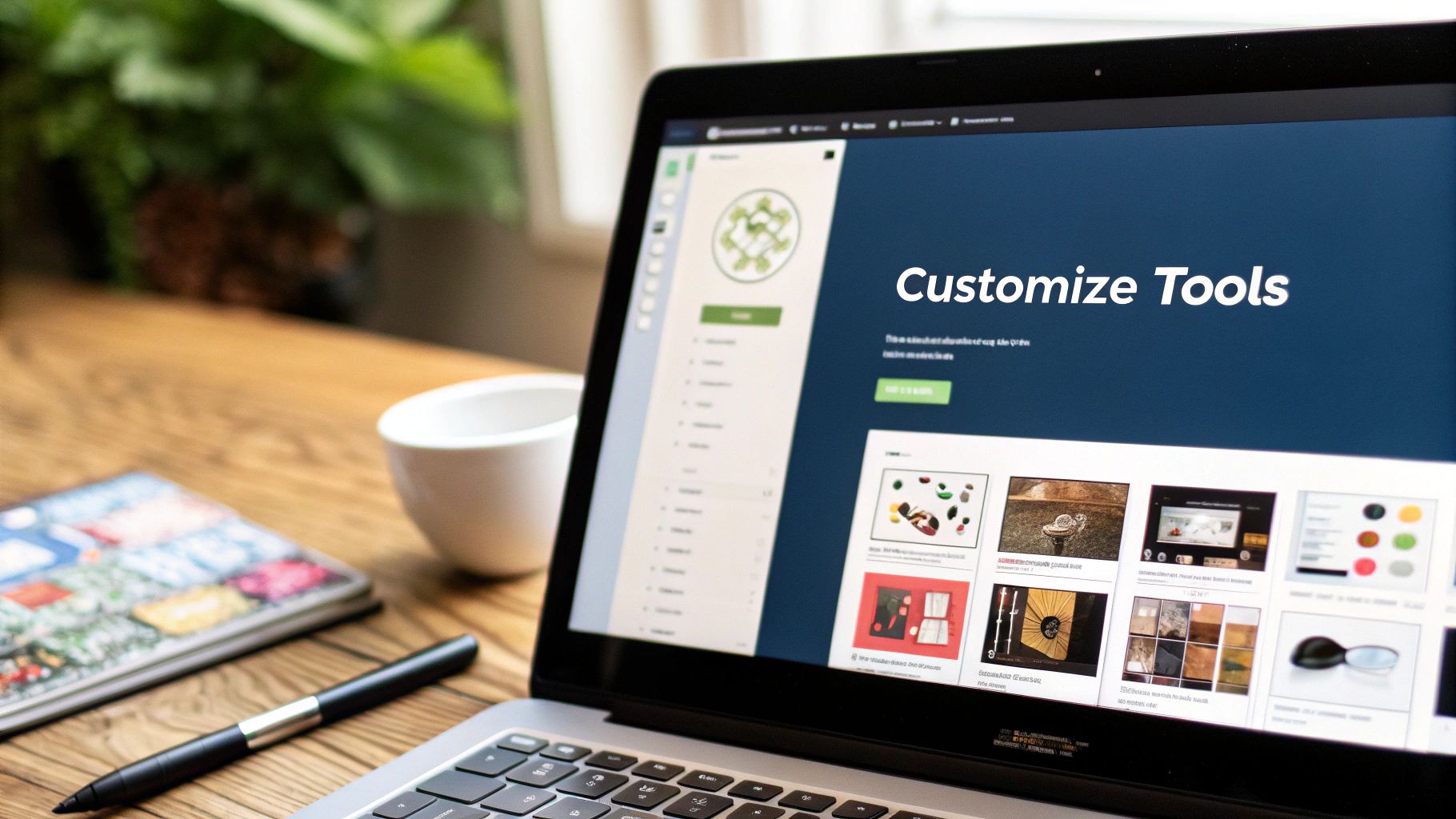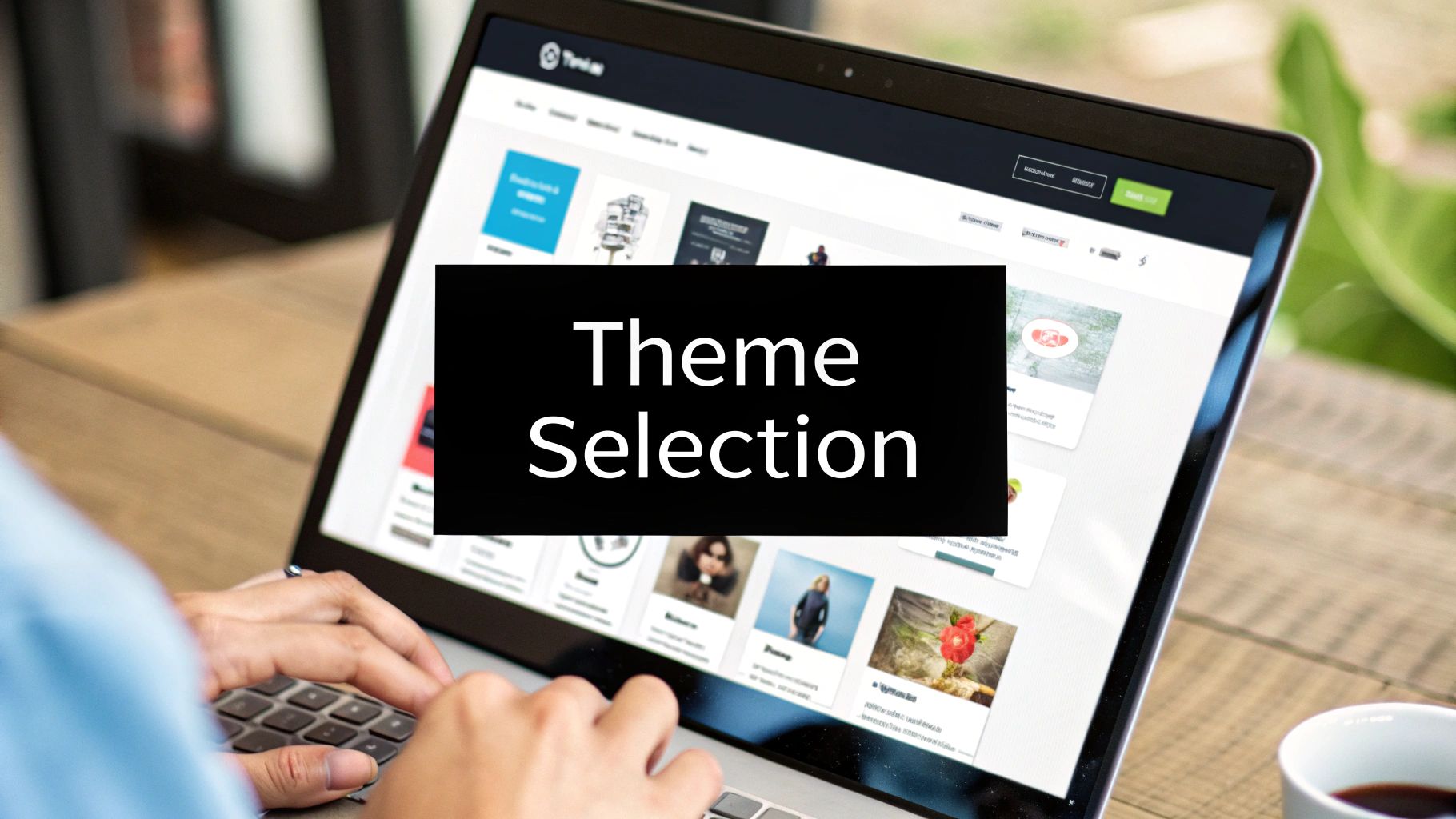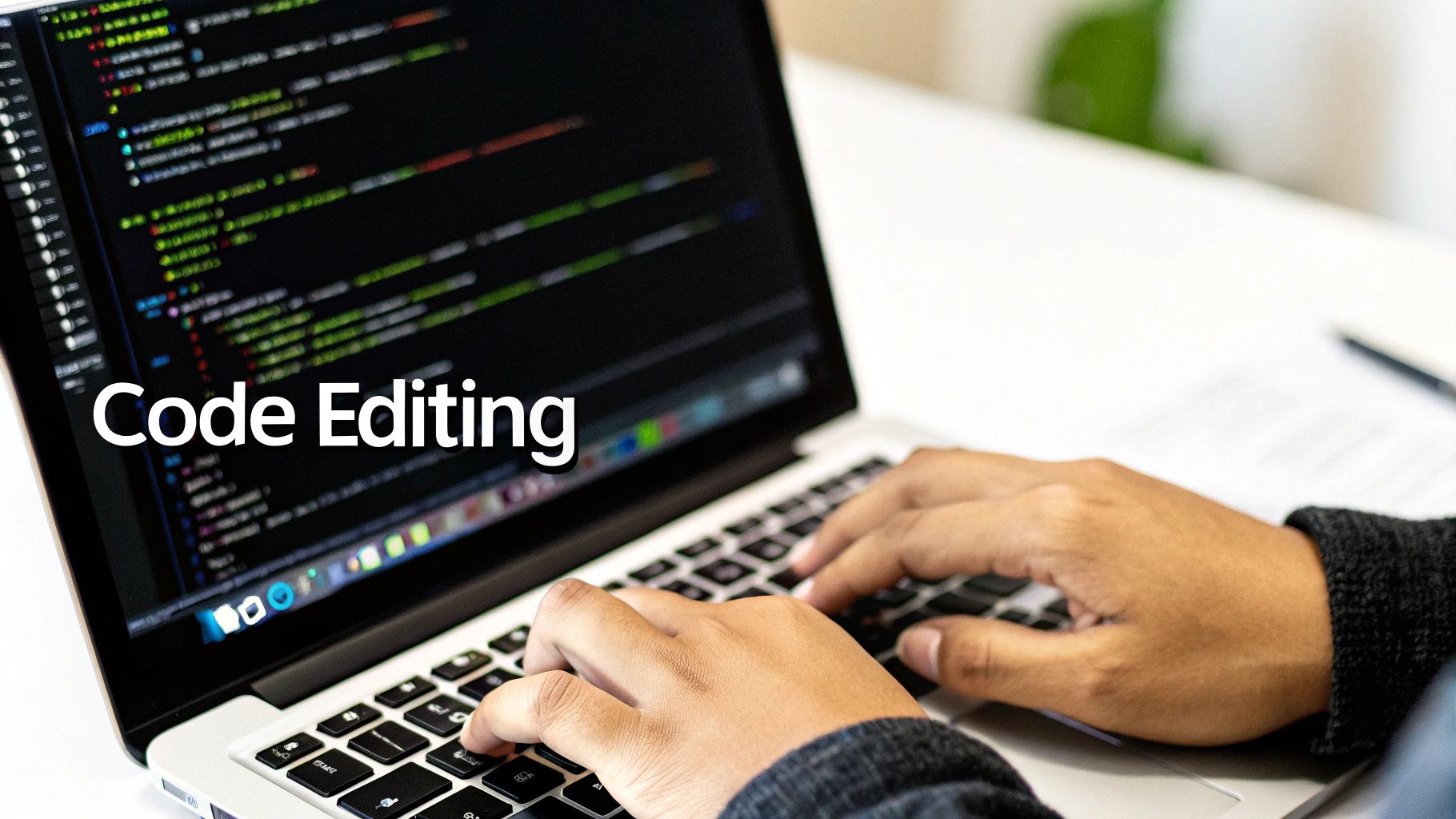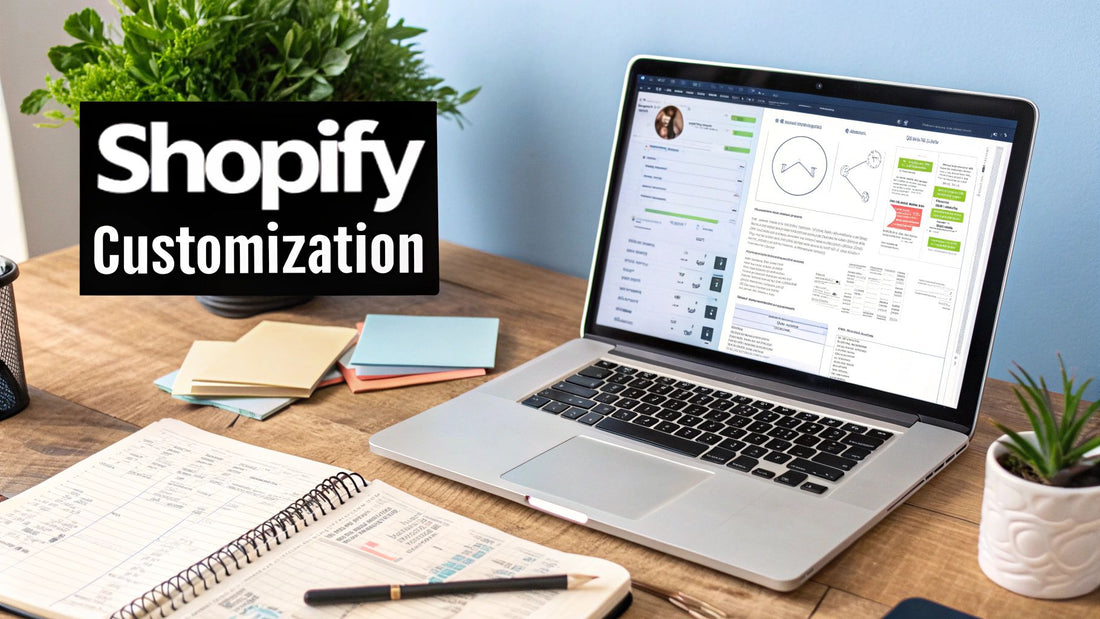Understanding Your Theme Customization Journey
Creating a Shopify store that reflects your brand identity involves more than basic visual changes. Whether you're making simple adjustments or complex modifications, understanding the customization options helps you build an online store that connects with your customers.
Basic Theme Settings vs. Advanced Customizations
The theme editor in your Shopify dashboard lets you make quick visual updates without any coding knowledge. You can change colors, fonts, logos, and social media links - similar to redecorating a room with new furnishings. This makes it easy to refresh your store's look for seasonal promotions or modernize your typography.
For more extensive changes, you'll need advanced customizations. This involves working with Liquid (Shopify's template language), HTML, CSS, and JavaScript to modify your store's functionality and layout. Think of it like renovating a house - you can change the structure and add custom features to create something truly unique to your brand.
Making the Most of Shopify
Successful brands combine both approaches effectively. They use the theme editor for quick updates while implementing custom code for more complex features. This balanced strategy helps maintain brand consistency while delivering an engaging shopping experience. The key is choosing customization methods that align with your current business requirements.
Custom Shopify themes give brands full control over their store's appearance and functionality. This is especially valuable for established businesses or those growing into larger markets. A custom theme provides complete ownership of your ecommerce presence from day one, with flexibility to scale as your business expands. Learn more about custom Shopify themes
Planning Your Customization Strategy
Start by clearly defining your goals. Are you focused on improving conversion rates, strengthening brand recognition, or creating a better shopping experience? Once you identify your objectives, you can determine which customization level best fits your needs. This focused approach ensures your efforts directly support your business goals and helps maximize your store's effectiveness.
Essential Tools and Resources for Successful Customization

Making changes to your Shopify store requires some key tools and resources. Having the right setup helps both store owners and developers make changes more efficiently.
The Shopify Theme Editor
The Theme Editor is where most of your customization work happens. It offers a simple way to change colors, fonts, and layouts without touching any code. You can see your changes instantly as you make them, which helps you perfect your store's look.
Key benefits include:
- Direct access from your Shopify admin dashboard
- Real-time preview of all changes
- Simple interface that anyone can use
Liquid Template Language
Liquid is the code language that powers Shopify themes. Learning Liquid lets you make more detailed changes to your store that go beyond basic settings. Think of it like learning a new language - you'll combine different pieces to create exactly what you want.
Main features:
- Built by Shopify as a free, open-source tool
- Allows for custom page designs and features
- Powers dynamic content across your store
Recommended Development Tools
Setting up a proper development environment helps prevent mistakes and makes teamwork smoother. Here are the essential tools you'll want:
- GitHub or Bitbucket: Track changes and work with others
- Visual Studio Code: A powerful code editor with many helpful features
- Shopify CLI: Work on themes locally on your computer
Having these tools in place from the start saves time and helps avoid common problems down the road.
Free vs Paid Options
When choosing tools, you'll need to decide between free and paid options:
- Compare features: Premium themes often include support and extra features
- Consider your needs: Match your tool choices to what your store actually requires
By picking the right mix of tools and resources, you can make your Shopify store stand out while keeping the customization process manageable.
Making the Right Choice: Pre-Built vs Custom Themes

Selecting a Shopify theme is one of the most important decisions you'll make for your online store. The theme you choose affects how your brand is perceived, how well your store can grow, and your overall success. You have two main choices: pre-built themes or custom themes. Each option has its own benefits and limitations.
Pre-Built Themes: Quick and Cost-Effective
Pre-built themes offer a straightforward path to launching your store. These ready-to-use templates work well for new businesses with limited budgets since they cost less and don't require technical skills to set up. The Shopify Theme Store features both free and paid options, each designed with specific industries and styles in mind.
The main drawback of pre-built themes is limited customization. While you can change basic elements like colors and fonts through the theme editor, making major structural changes usually requires coding knowledge. This can make it harder to create a unique store that stands out from competitors.
Custom Themes: Tailored to Your Brand
Custom themes give you full control over your store's look and functionality. They're built specifically for your business needs, letting you create a unique shopping experience. This makes them ideal for established brands that want to stand out in their market and need specific features not found in pre-built themes.
The downside is that custom themes need more time and money to develop. You'll typically need to hire a professional Shopify developer, which increases costs. Plus, maintaining and updating a custom theme requires ongoing technical support.
Hybrid Approach: Balancing Customization and Practicality
Many store owners find success with a hybrid approach - starting with a pre-built theme and adding custom features over time. This method helps balance uniqueness with practicality. Tools like Section Store can add pre-made sections to any theme, increasing design options without extensive coding.
Your choice should depend on three key factors: timeline, budget, and customization needs. Pre-built themes work well for quick launches and smaller budgets but may limit your design options. Learn more about custom themes if you need specific features or want complete control over your store's design. The key is matching your choice to your business goals and resources.
Understanding the Real Costs of Theme Customization
When investing in a Shopify theme customization, it's essential to look beyond just the upfront price tag. The true costs involve multiple factors that can impact your budget both short and long-term. Let's explore what you really need to know about theme customization expenses to help you plan effectively.
Beyond the Price Tag: Factors Influencing Customization Costs
Several key elements affect how much you'll spend on customizing your Shopify theme:
-
Complexity Level: Basic changes like updating colors and fonts typically cost less than major structural modifications. Think of it as the difference between repainting a room versus renovating the entire layout.
-
Theme Selection: Your choice of theme impacts customization costs significantly. While free themes offer basic options, paid themes from the Shopify Theme Store provide more flexibility but at a higher price point.
-
Developer Skills: When hiring help, developer experience directly affects rates. Expert Shopify developers command higher fees than those new to the platform.
-
Maintenance Needs: Factor in ongoing costs for updates, bug fixes, and general upkeep after the initial customization work.
Budgeting for Shopify Theme Customization
To plan your customization budget effectively:
-
Create Clear Requirements: List exactly what changes you need. Having detailed specifications helps prevent scope creep.
-
Compare Options: Look at different solutions - from pre-built sections to hiring developers. Get multiple quotes.
-
Stage Your Changes: Break down customizations into phases to spread costs over time and prioritize critical updates.
-
Add Buffer Funds: Include extra budget (15-20%) for unexpected needs or revisions.
Maximizing Your ROI
Focus customization efforts on changes that directly impact your business goals. For example, if you want to boost sales, prioritize improving product pages and checkout flow. Use analytics to measure the impact of each change and adjust your strategy based on real data.
Hidden Expenses to Watch Out For
Be aware of these often-overlooked costs:
- Third-Party Apps: Many customizations require additional apps with monthly fees
- Visual Content: Professional photos and videos can add significant costs
- Speed Optimization: Making sure your customized store loads quickly may need extra development work
By understanding these real costs of Shopify theme customization, you can create an effective budget and build an online store that serves your business goals while avoiding unnecessary expenses.
Mastering Basic Theme Customization Techniques

Making your Shopify store look great doesn't require advanced coding skills. The platform offers built-in tools that give you control over essential design elements like colors, fonts, and layouts. This guide will show you how to make simple yet effective changes that improve both the look and usability of your store.
Customizing Colors and Typography
The Theme Editor serves as your main control center for basic design changes. Here you can adjust your store's color scheme to align with your brand identity by modifying backgrounds, buttons, and text colors. Font selection is just as straightforward - pick from the available options or add your own custom fonts. The right combination of colors and typography helps shape how customers view your brand and impacts their shopping journey.
Refining Your Store Layout
The Theme Editor also lets you modify your store's structure and organization. Think of it as rearranging furniture in a physical store - you can adjust section sizes, move elements around, and add or remove entire blocks to create better product displays. A well-designed homepage helps guide visitors to key areas like featured collections or company information. You might want to showcase new items or highlight special offers to catch customers' attention.
Optimizing for Mobile
Since many people shop on their phones and tablets, creating a smooth mobile experience is essential. The Theme Editor includes tools to preview and fine-tune how your store appears on different devices. This ensures customers have a consistent, user-friendly experience whether they're shopping on desktop or mobile. Making sure images and content work well on mobile also helps your site load faster and run better.
Leveraging Pre-built Sections with Section Store
While the Theme Editor provides good basic options, using pre-built sections can add extra polish to your design. Section Store offers ready-made design elements that work with any theme - from product displays to customer reviews. These sections help you create unique layouts without coding knowledge. The pre-built sections maintain quality and responsiveness across your site. For a one-time fee, Section Store lets you add custom sections without ongoing subscription costs.
Advanced Customization Strategies That Drive Results

Going beyond basic theme settings unlocks powerful capabilities for your Shopify store. By mastering advanced customization techniques, you can create a distinctive brand experience that delivers real business growth. While these strategies require deeper technical knowledge, the potential impact makes the investment worthwhile.
Implementing Custom Sections
Custom sections give you precise control over your store's content and features. You can build specialty components like product carousels, customer testimonial displays, or any other custom content block your brand needs. Think of it like adding purpose-built rooms to your store - each section serves a specific function while maintaining your overall brand aesthetic.
Leveraging Advanced Liquid Programming
Shopify's Liquid templating language provides robust tools for displaying and processing data. When you master filters, tags, and objects, you can create personalized shopping experiences based on customer behavior. For example, you might show targeted product recommendations or adjust checkout flows based on cart value.
Seamless Third-Party Integrations
Adding external apps and services multiplies what your store can do. The key is integrating these tools smoothly into your theme for a cohesive experience. This could mean embedding shipping calculators directly in product pages or incorporating loyalty program features throughout the shopping journey. Well-executed integrations boost customer satisfaction and encourage repeat purchases.
Best Practices for Code Organization and Maintenance
As customizations grow more complex, good code management becomes essential:
- Use version control systems like Git to track changes effectively
- Follow consistent coding patterns for better readability
- Test customizations regularly to ensure compatibility
These practices prevent future problems and make ongoing updates easier, especially when working with other developers.
Optimizing Performance
Complex customizations can affect site speed if not carefully implemented. Follow proven optimization techniques like image compression and minimizing HTTP requests to keep your store running smoothly. Fast page loads improve both user experience and search rankings, leading to more traffic and sales.
Measuring the Impact of Customizations
Track how your customizations affect key metrics. Use A/B testing to compare different versions and monitor conversion rates and bounce rates. This data-driven approach ensures your customization work delivers meaningful business results.
By applying these advanced strategies thoughtfully, you can build a truly unique store that stands out from standard Shopify themes. Focus on customizations that enhance the customer experience and support your business goals.
Want an easier way to add pre-designed sections to your Shopify theme? Check out Section Store for a collection of ready-to-use sections compatible with any theme, available for a one-time fee.
Article created using Outrank


